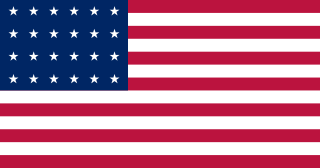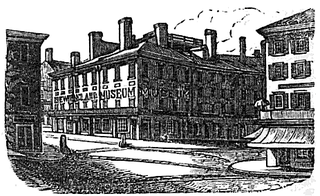 W
WThe Territory of Arkansas, officially the Territory of Arkansaw, and commonly known as the Arkansas Territory or the Arkansaw Territory, was an organized incorporated territory of the United States that existed from July 4, 1819, to June 15, 1836, when the final extent of Arkansas Territory was admitted to the Union as the State of Arkansas. Arkansas Post was the first territorial capital (1819–1821) and Little Rock was the second (1821–1836).
 W
WFreedom's Journal was the first African-American owned and operated newspaper published in the United States. Founded by Rev. John Wilk and other free black men in New York City, it was published weekly starting with the 16 March 1827 issue. Freedom's Journal was superseded in 1829 by The Rights of All, published between 1829 and 1830 by Samuel Cornish, the former senior editor of the Journal.
 W
WGeorge Washington, elected the first president in 1789, worked with the heads of the departments of State, Treasury, and War, along with an Attorney General, the group of which later became known as his cabinet. Based in New York, the new government acted quickly to rebuild the nation's financial structure. Enacting the program of Treasury Secretary Alexander Hamilton, the government assumed the Revolutionary War debts of the states and the national government, and refinanced them with new federal bonds. It paid for the program through new tariffs and taxes; the tax on whiskey led to a revolt in the west; Washington raised an army and suppressed it. The nation adopted a Bill of Rights as 10 amendments to the new constitution. Fleshing out the Constitution's specification of the judiciary as capped by a Supreme Court, the Judiciary Act of 1789 established the entire federal judiciary. The Supreme Court became important under the leadership of Chief Justice John Marshall (1801–1835), a federalist and nationalist who built a strong Supreme Court and strengthened the national government.
 W
WThe Marshall Court refers to the Supreme Court of the United States from 1801 to 1835, when John Marshall served as the fourth Chief Justice of the United States. Marshall served as Chief Justice until his death, at which point Roger Taney took office. The Marshall Court played a major role in increasing the power of the judicial branch, as well as the power of the national government.
 W
WThe Massachusetts General Colored Association was organized in Boston in 1826 to combat slavery and racism. The Association was an early supporter of William Lloyd Garrison. Its influence spread locally and was realized within New England when they joined the New England Anti-Slavery Society in 1833.
 W
WThe New-England Museum in Boston, Massachusetts, was established at 76 Court Street by Ethan A. Greenwood, Peter B. Bazin, John Dwight and Samuel Jackson. It featured displays of fine art, natural history specimens, wax figures, and other curiosities. Bands of musicians typically performed there during public hours.
 W
WPendleton's Lithography (1825–1836) was a lithographic print studio in 19th-century Boston, Massachusetts, established by brothers William S. Pendleton (1795-1879) and John B. Pendleton (1798-1866). Though relatively short-lived, in its time the firm was prolific, printing portraits, landscape views, sheet music covers, and numerous other illustrations. The Pendleton's work might be characterized by its generosity—each print contains a maxima of visual information designed for graphic reproduction.
 W
WThe presidency of Andrew Jackson began on March 4, 1829, when Andrew Jackson was inaugurated as President of the United States, and ended on March 4, 1837. Jackson, the seventh United States president, took office after defeating incumbent President John Quincy Adams in the bitterly contested 1828 presidential election. During the 1828 presidential campaign, Jackson founded the political force that coalesced into the Democratic Party during Jackson's presidency. Jackson won re-election in 1832, defeating National Republican candidate Henry Clay by a wide margin. He was succeeded by his hand-picked successor, Vice President Martin Van Buren, after Van Buren won the 1836 presidential election.
 W
WThe presidency of John Quincy Adams began on March 4, 1825, when John Quincy Adams was inaugurated as President of the United States, and ended on March 4, 1829. Adams, the sixth United States president, took office following the 1824 presidential election, in which he and three other Democratic-Republicans—Henry Clay, William H. Crawford, and Andrew Jackson—sought the presidency. There was no preliminary party primary six months before the general election, as became the custom. No candidate won a majority of Electoral College votes, and so the United States House of Representatives chose the president in a contingent election. With the help of Clay, Adams was elected by the House, and Clay became Adams's Secretary of State.
 W
WThe Marquis de Lafayette was the last surviving French general of the American Revolutionary War in 1824, and he made a tour of the 24 states in the United States from July 1824 to September 1825. He was received by the populace with a hero's welcome at many stops, and many honors and monuments were presented to commemorate and memorialize the visit.